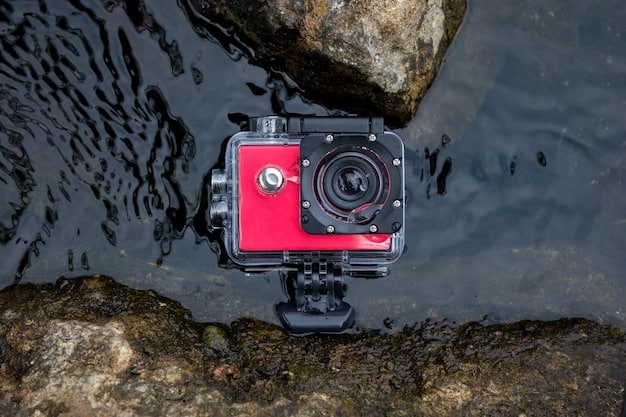Action Camera Review: Which $300 Model Shoots Best 4K Video in 2025?

Navigating the competitive landscape of action cameras under $300 in 2025 requires careful consideration of feature sets and video quality, with specific models emerging as top contenders for superior 4K footage without breaking the bank.
In the rapidly evolving world of portable electronics, finding the perfect companion for your adventures can be a thrilling yet daunting task. Our quest today zeroes in on a particularly exciting niche: the Action Camera Review: Which $300 Model Shoots the Best 4K Video in 2025? As technology advances, the line between premium and budget increasingly blurs, making high-quality, ultra-HD recording more accessible than ever. This comprehensive review aims to cut through the marketing noise, offering clarity on which models truly deliver stunning 4K video performance at an affordable price point, ensuring your memories are captured with exceptional detail and clarity.
Understanding 4K Video in Action Cameras
The term “4K” has become a ubiquitous selling point for many electronic devices, but what does it truly mean when applied to an action camera, especially one priced under $300 in 2025? Essentially, 4K resolution refers to a display or content having roughly 4,000 pixels horizontally. In the context of action cameras, this typically translates to a resolution of 3840 x 2160 pixels. This offers four times the pixel density of standard 1080p Full HD, resulting in significantly sharper, more detailed, and vibrant footage.
However, simply having the ability to record in 4K isn’t the sole determinant of quality. The frame rate at which this 4K footage is captured plays a crucial role. For fluid, cinematic results, a minimum of 24 frames per second (fps) is recommended. For fast-paced action or the ability to create smooth slow-motion effects, 30fps or even 60fps at 4K resolution becomes highly desirable. Many budget cameras claim 4K, but deliver it at lower frame rates, which can result in less smooth playback, particularly for dynamic scenes.
The Sensor and Processor Synergy
At the heart of any camera’s image quality are its sensor and image processor. Even with 4K capabilities, a small or low-quality sensor will struggle in challenging lighting conditions, leading to noisy or underexposed footage. A robust image processor is equally vital, as it handles the immense amount of data generated by 4K recording, ensuring efficient compression without significant loss of detail, and contributes to features like dynamic range and color accuracy. In 2025, advancements in these components are making higher quality 4K accessible in more budget-friendly action cameras than ever before.
When evaluating a camera’s 4K prowess, consider:
- Resolution and Frame Rate: Look for 4K at 30fps as a minimum, with 60fps being a strong bonus for fluidity.
- Sensor Size: While often not explicitly stated for budget models, a larger sensor generally performs better in low light.
- Image Stabilization: Electronic Image Stabilization (EIS) or better, Hypersmooth-type stabilization, is critical for smooth 4K footage from a vibrating action camera.
Beyond the technical specifications, the actual usability and performance of the 4K mode in real-world scenarios must be assessed. User reviews and sample footage are invaluable resources to gauge how effectively a camera manages its 4K capabilities in varied environments, from bright sunny days to challenging low-light conditions. A camera might claim 4K, but if it introduces significant overheating, battery drain, or severe image artifacts, its utility is severely limited.
Key Features to Look for in a $300 Action Camera
When selecting an action camera under $300 in 2025 with the primary goal of shooting excellent 4K video, a discerning eye for specific features is essential. It’s not just about the raw specifications; it’s about how these features coalesce to deliver a superior user experience and capture truly compelling footage. Beyond 4K resolution and adequate frame rates, several other attributes warrant close examination.
Image Stabilization: For action cameras, stabilization is paramount. Without it, even the steadiest hand or mount will produce shaky footage. In the sub-$300 category, you’ll primarily encounter Electronic Image Stabilization (EIS). While not as robust as the optical stabilization found in some premium models, advanced EIS algorithms have improved dramatically, offering surprisingly smooth video, especially at 4K 30fps. Look for cameras that specifically mention multi-axis EIS or advanced motion compensation.
Battery Life and Power Management
Recording 4K video is highly power-intensive. A camera that can only manage twenty minutes of 4K footage before needing a recharge is impractical for extended adventures. Prioritize models with:
- Decent Battery Capacity: Generally, anything above 1000mAh is a good starting point, but real-world performance varies.
- Swappable Batteries: The ability to quickly swap out a depleted battery for a fresh one extends recording time significantly. Many budget models now include a spare battery in the box.
- USB-C Charging: Allows for faster charging and sometimes, continuous power while recording if connected to a power bank.
Build Quality and Durability: Action cameras are designed to withstand rugged environments. Look for models that are inherently waterproof (without requiring an external housing for shallow depths), shockproof, and dustproof. Manufacturers often highlight specific IP ratings (e.g., IP68) which indicate resistance to dust and water. A robust build ensures the camera can handle the inevitable bumps, drops, and splashes that come with outdoor activities.

User Interface and Ease of Use: Even the most feature-rich camera is frustrating if it’s difficult to operate. A clear, intuitive touchscreen interface is a major plus, allowing for quick adjustments while on the go. Physical buttons should be responsive and easy to press, even with gloves on. Furthermore, consider the accompanying smartphone app – a well-designed app can greatly enhance the experience for remote control, quick editing, and sharing of footage.
Audio Quality: While primary focus is on video, good audio can significantly elevate the overall quality of your content. Most action cameras struggle with wind noise. Some models include wind noise reduction features or offer options for connecting an external microphone (though this is rarer in the sub-$300 category). If audio is critical for your content, research independent reviews specifically addressing sound performance.
Top Contenders for Best 4K Video Under $300 in 2025
As we delve into 2025, the sub-$300 action camera market has matured considerably, offering compelling alternatives to the high-end flagships. Manufacturers are pushing the boundaries of what’s possible at this price point, particularly in 4K video quality. While specific model names can shift rapidly in this segment, certain brands and feature sets consistently deliver value. Here, we highlight the types of contenders you should be looking for, focusing on the balanced performance that makes for the best 4K video output without overshooting the $300 budget.
One primary type of contender typically comes from established budget-friendly brands that have spent years refining their offerings. These cameras often leverage slightly older but still highly capable sensors and processors that have been cost-optimized. They might not feature the absolute latest bleeding-edge innovations found in cameras three times their price, but they excel in delivering reliable, sharp 4K video at 30 or even 60 frames per second. Their stabilization systems, while mostly electronic, are often very effective, providing a smooth visual experience for most action sports and vlogging scenarios.
Emerging Brands and Their Value Propositions
Another strong category of contenders arises from newer, more agile brands that focus heavily on value. These companies often come to market with a single, highly competitive model, packed with features that directly compete with mid-range offerings from larger players. Their advantage often lies in leaner production and direct-to-consumer sales, allowing them to pass savings onto the customer. When assessing these, it’s crucial to look beyond the marketing hype and examine independent reviews and sample footage to verify their 4K claims and overall image quality in real-world conditions. Factors like customer support and firmware update frequency also become more important with these newer players.
- SJCAM and AKASO: These brands have consistently been strong players in the budget action camera market. Their 2025 offerings are likely to feature improved EIS, better low-light performance, and refined user interfaces. Expect stable 4K 30fps, with some models pushing into 4K 60fps, though perhaps with some compromises in extreme conditions.
- DJI Osmo Action 3 (or its successor, if priced competitively): While sometimes sitting just above the $300 mark, previous DJI Osmo Action models have seen price drops that make them incredibly compelling once new versions are released. If a DJI model falls within the budget, its RockSteady stabilization and robust build quality make it a top-tier choice for 4K video. It represents a premium experience at a near-budget price.
- Crosstour, Dragon Touch, and Other Amazon-centric Brands: These brands excel at packing a lot of features for a very low price. While their 4K can sometimes be interpolated or less refined than higher-tier options, their latest models often deliver surprisingly good daytime 4K footage. They are excellent choices for casual users or those needing multiple cameras for different angles.
When assessing any of these contenders, pay close attention to nuances like color reproduction, dynamic range, and low-light performance. A camera might shoot 4K, but if the colors are washed out or shadows are crushed, the overall impact is diminished. Conversely, a camera that captures vibrant, well-exposed 4K footage even in challenging light, alongside effective stabilization, provides true value and often outperforms its price tag, making it a strong candidate for the best 4K action camera under $300 in 2025.
Real-World Testing: What Matters for 4K Output
Benchmarking an action camera purely on its specifications can be misleading, especially when dissecting its 4K performance within a $300 budget. The true test lies in real-world application, where environmental factors, user interaction, and the camera’s internal processing prowess reveal its actual capabilities. For 4K video, this means going beyond simply checking a box for “4K resolution” and diving deeper into practical considerations that directly impact the quality of your footage.
One of the most critical aspects of real-world 4K testing is assessing how well the camera handles varying light conditions. Many budget cameras perform adequately in bright, direct sunlight. However, their true limitations often surface in challenging scenarios such as heavily shadowed areas, mixed lighting (like a forest path), or low-light situations (dusk, indoor action). A strong contender for best 4K video will exhibit good dynamic range, preserving detail in both highlights and shadows, and demonstrate minimal digital noise when light is scarce. The ability to maintain color accuracy and saturation across these lighting extremes is also a strong indicator of a superior 4K engine.
Stabilization Performance Under Duress
For an action camera, stabilization is perhaps even more critical than raw resolution. While many offer Electronic Image Stabilization (EIS), the effectiveness varies wildly. Real-world testing involves mounting the camera on various platforms – helmets, handlebars, chest straps – and subjecting it to typical action scenarios: running, biking over rough terrain, skiing, or even handheld vlogging while walking quickly. The goal is to observe how well the EIS corrects for jarring movements without introducing undesirable artifacts like jello effect, warping, or excessive cropping. Cameras that offer fluid, natural-looking 4K footage even during intense motion are clear winners.
- Motion Artifacts: Look for any signs of “jello effect” (wobbly footage) or excessive pixelation during rapid movement.
- Focusing Speed and Accuracy: An action camera needs to maintain sharp focus on the action. Test continuous autofocus if available, or assess how quickly it adjusts to new subjects.
- Color Science: Evaluate if the colors are vibrant and true-to-life, or if they appear oversaturated, desaturated, or have an unnatural cast.
Another often overlooked aspect of real-world 4K testing is thermal management. Recording high-resolution 4K video generates significant heat. Some budget cameras can overheat during extended recording sessions, leading to shutdowns or a drop in frame rate/resolution. Continuous recording tests are crucial to understand its limits. Finally, sound quality in real-world scenarios, particularly with wind noise reduction, can vastly improve the storytelling aspect of 4K video. A camera might capture stunning visuals, but if the audio is unintelligible, the overall production value suffers. Evaluating all these factors together, beyond mere numbers, provides a holistic view of a camera’s true 4K video prowess.
Software, Firmware, and User Experience
The journey of capturing stunning 4K video with an action camera extends far beyond the hardware itself; the software ecosystem, crucial firmware updates, and the overarching user experience play an equally pivotal role. In the $300 segment, where hardware might have some limitations, well-optimized software can significantly enhance performance and usability, translating to a better overall 4K capture workflow.
A crucial element of the software experience is the camera’s user interface (UI). Whether accessed via a touchscreen, physical buttons, or a companion smartphone app, an intuitive UI allows users to quickly navigate menus, change settings, and initiate recording without fumbling. For 4K video, this means easy access to frame rates, resolution options, stabilization settings, and white balance. A clunky or slow UI can be incredibly frustrating in dynamic action scenarios, potentially causing missed shots. In 2025, even budget cameras are expected to offer reasonably responsive touchscreens and logical menu structures.
The Importance of Firmware Updates
Firmware updates are arguably the lifeline for any modern electronic device, and action cameras are no exception. For a $300 action camera, a manufacturer’s commitment to regular firmware updates can transform a good camera into a great one. These updates often bring:
- Performance Enhancements: Improved 4K video quality, better low-light performance, and enhanced image stabilization.
- Bug Fixes: Resolving issues like overheating, battery drain, or connectivity problems.
- New Features: Adding new recording modes, advanced controls, or compatibility with new accessories.
A brand that consistently releases firmware updates demonstrates a commitment to its product and user base, ensuring the camera evolves over time rather than becoming obsolete shortly after purchase. Before committing to a purchase, it’s worth checking the manufacturer’s support page for a history of firmware releases.

The companion smartphone app is another vital component of the user experience. A well-designed app facilitates seamless connectivity for remote control, allowing users to start/stop recording, change settings, and preview footage from a distance. More importantly, it often serves as a quick platform for viewing, downloading, and even basic editing of 4K clips. The ability to trim, color correct slightly, and directly share 4K videos from the app without needing to transfer to a computer streamlines the content creation process. An app that crashes frequently, is slow, or lacks essential features can negate much of the camera’s hardware potential. Ultimately, a strong blend of responsive UI, meaningful firmware updates, and a capable smartphone app is what elevates a contender in the $300 4K action camera space, delivering not just raw video files, but a genuine and enjoyable recording experience.
Value Proposition: Beyond Just 4K Video
While our primary focus remains on determining which $300 action camera shoots the best 4K video in 2025, the true value proposition of any consumer electronic device extends beyond its core functionality. For action cameras, this holistic view encapsulates the entire package, including accessories, ecosystem compatibility, warranty, and potential resale value. A camera might technically deliver excellent 4K, but if it lacks essential accessories or has a poor support network, its overall worth diminishes.
Many budget action cameras are known for their generous inclusion of accessories. Unlike their premium counterparts where mounts and cases are often sold separately, sub-$300 models frequently come bundled with a wide array of attachments. This can include waterproof housings, helmet mounts, handlebar mounts, extra batteries, charging cables, and various clips. The immediate availability of these accessories can save a considerable amount of money and time that would otherwise be spent purchasing them piecemeal. This upfront saving allows users to immediately utilize the camera in diverse scenarios, enhancing its practical utility for 4K video capture without additional investment.
Warranty and Customer Support Considerations
The reliability of customer support and the duration/coverage of the warranty are critical, particularly for budget electronics. While the price point is attractive, knowing that potential issues can be addressed without significant hassle adds immense value. Look for brands that offer at least a 1-year warranty and have accessible customer service channels (email, phone, or live chat). Prompt responses and effective problem resolution indicate a manufacturer that stands behind its product, providing peace of mind to the user about their 4K video investment.
- Accessory Ecosystem: Is the camera compatible with common action camera mounts (e.g., GoPro-style)? This allows for greater flexibility and re-use of existing gear.
- Community Support: A vibrant online community (forums, social media groups) can be an invaluable resource for troubleshooting, tips, and sharing experiences, especially for specific 4K shooting techniques.
- Software Compatibility: Does the camera’s 4K footage play well with common editing software? Are there specific codecs or file types that might cause issues?
Finally, consider the potential for future use and resale. While no action camera retains its full value, a model known for its robust 4K performance and reliable build quality will likely fare better in the second-hand market if you decide to upgrade later. The cumulative effect of these non-video attributes – from generous accessory bundles and robust customer support to broad compatibility and a strong community – significantly contributes to the overall value of a budget action camera. It transforms a device that simply records 4K into a true adventure companion, making the choice for the best $300 model in 2025 truly comprehensive.
Future-Proofing Your $300 4K Action Camera Investment
Investing in an action camera, even one within the $300 budget, necessitates a consideration of its longevity and adaptability to future trends. While outright future-proofing is nearly impossible in the fast-paced world of technology, certain features and capabilities can help ensure your chosen 4K action camera remains relevant and capable for several years beyond 2025. This involves looking beyond immediate needs to anticipate evolving standards and usage patterns in action camera videography.
One primary aspect of future-proofing relates to video codecs and compression efficiency. As 4K resolution becomes standard, the efficiency with which video files are compressed becomes paramount for storage and sharing. Look for cameras that support modern, efficient codecs like H.265 (HEVC), in addition to the more common H.264. H.265 can deliver similar video quality to H.264 at roughly half the file size, which is a significant advantage for 4K footage that consumes vast amounts of storage space. A camera supporting this codec will make your workflow smoother and less demanding on your storage solutions in the long run.
Connectivity and Ecosystem Integration
The ability of your action camera to seamlessly integrate with other devices and platforms is another key future-proofing element. Look for robust Wi-Fi (preferably 5GHz for faster transfers) and Bluetooth connectivity. These not only enable remote control via smartphone apps but also facilitate quicker offloading of large 4K files and potential future integration with IoT devices or cloud services. Additionally, features like GPS data logging, while not strictly video-related, add valuable metadata to your 4K footage, enriching the storytelling potential and preparing for potential augmented reality overlays or advanced mapping applications down the line.
- Modular Design: While rare in this price range, some cameras offer modularity (e.g., removable lens covers, external microphone adapters) which can extend their lifespan by allowing component replacement or upgrades.
- Broad Mount Compatibility: Ensure the camera uses standard action camera mounts, allowing it to integrate with a vast ecosystem of accessories, regardless of brand.
- Resolution Scalability: While 4K is the goal, check if the camera offers higher resolutions like 5K (even if at lower frame rates). While you might not use it initially, it indicates a more capable sensor and processor, offering room to grow.
Finally, the overall build quality and durability are foundational to future-proofing. A camera that physically withstands the rigors of adventure for years minimizes the need for premature replacement due to wear and tear. Water resistance, shock absorption, and lens protection features, even if they add a slight cost, are invaluable for extending the life of your 4K action camera. By considering these proactive measures, your $300 investment in 2025 will continue to deliver excellent 4K video and remain a capable tool for many adventures to come.
| Key Point | Brief Description |
|---|---|
| 🎥 4K Video Quality | Focus on true 4K at 30fps or 60fps for sharp, detailed footage within budget. |
| ⚙️ Image Stabilization | Effective EIS is crucial for smooth video, even in action-packed scenarios. |
| 🔋 Battery & Durability | Prioritize swappable batteries and a robust, waterproof build for extended use. |
| ✨ User Experience | Intuitive UI, reliable app, and regular firmware updates enhance overall satisfaction. |
Frequently Asked Questions
▼
For budget cameras, “true 4K” typically means capturing video at a resolution of 3840×2160 pixels with a native sensor, not simply upscaling lower resolution footage. It also implies a stable frame rate, ideally 30 or 60 frames per second (fps), ensuring smooth and detailed video without significant drops in quality or visible interpolation. Be wary of models that only claim 4K but deliver it at very low frame rates, as this can degrade the viewing experience.
▼
Yes, advanced EIS has become surprisingly effective in sub-$300 action cameras by 2025. While it may not match optical image stabilization (OIS) found in premium models, modern EIS algorithms can significantly smooth out shakes and jitters, making 4K footage much more watchable. Look for cameras with multi-axis EIS for the best results, as it provides a notable improvement in stability for dynamic activities.
▼
Battery life is crucial when shooting 4K video, as it drains power significantly faster than lower resolutions. For comprehensive recording sessions, it’s highly important. Seek out cameras that offer at least 60-90 minutes of 4K recording time per charge, or, more realistically in this price range, include swappable batteries or even one or two spare batteries in the box. This ensures you can capture all your adventures without constant recharging interruptions.
▼
While low-light performance in action cameras has improved across the board, it remains a challenge for budget models. You can expect reasonable performance in moderately lit conditions, but significant noise and loss of detail are common in very dim environments. Some models might feature specific low-light modes, but temper your expectations for cinematic results in scenarios requiring substantial light amplification. Dedicated large-sensor cameras will always outperform action cameras in this regard.
▼
Many budget action cameras offer impressive accessory bundles, maximizing their value. Key inclusions to look for are a waterproof housing (if the camera isn’t natively waterproof), multiple mounting options (helmet, handlebar, chest strap), at least one extra battery and a charging cable. A remote control, spare adhesive mounts, and various clips are also valuable additions that allow immediate use across a variety of scenarios without extra purchases.
Conclusion
Navigating the competitive landscape of action cameras priced under $300 in 2025 reveals a vibrant market where true 4K video capabilities are increasingly accessible. While the top-tier contenders from established budget brands and emerging innovators might not always rival their premium counterparts in every single metric, they undeniably bridge a significant performance gap, delivering impressive value for their price point. The ultimate choice hinges on a careful balance of genuine 4K resolution at usable frame rates, effective electronic image stabilization, robust build quality, and a user-friendly experience bolstered by consistent firmware support. As this review has explored, by prioritizing these core aspects and understanding the nuances of real-world performance, adventurers and content creators can confidently select a model that captures their dynamic moments in stunning 4K detail without exceeding their budget.





